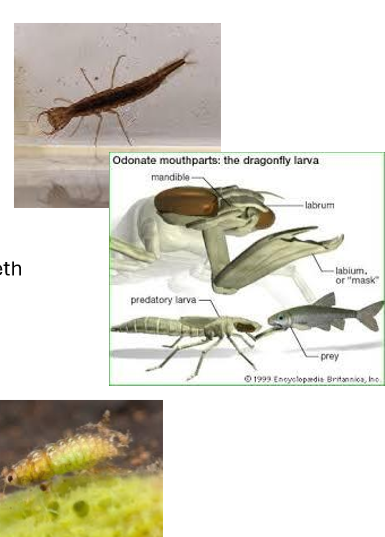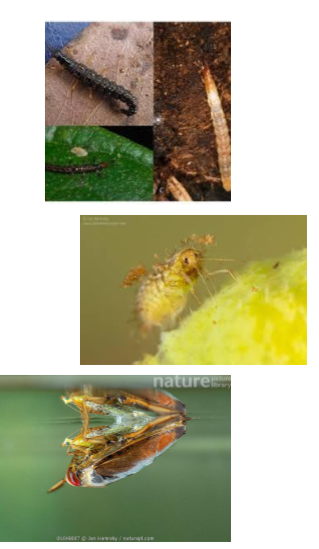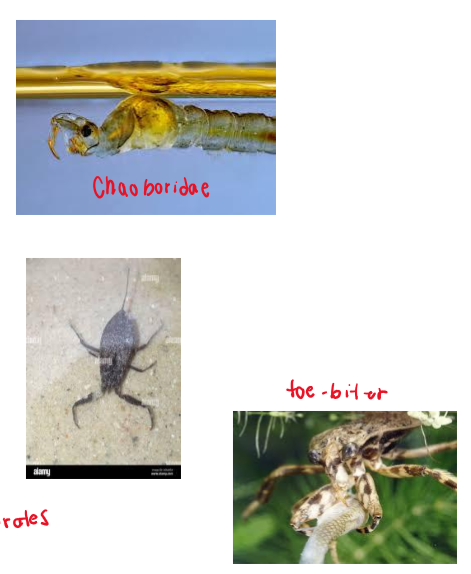Aquatic Entomology Lecture 6 - Feeding devices and foraging strategies
1/16
There's no tags or description
Looks like no tags are added yet.
Name | Mastery | Learn | Test | Matching | Spaced |
|---|
No study sessions yet.
17 Terms
What are the foods of aquatic insects (4)
Animal Prey
Generalist
Large Plants
Macrophytes and mosses
Herbivory is not common
Phytoplankton
Eat filamentous and attached algar
Biofilm
Detritus
Dead part of plants (fungi and bacteria)
> 1 mm = COURSE particulate organic matter (CPOM)
< 1 mm = FINE particulate organic matter (FPOM)
What are the functional feeding groups (7)
Predators
Engulfers
Piercers
Parasites
Shredders, chewers, and xylophages
Algal piercers/bursters
Grazers
Collecter-gatherers
Filter feeders

Predators
Animals that attack and consume other animal prey, typically alive when attacked
Engulfer
Piercing/sucking

Engulfers (Definition, adaptions 3)
Swallow prey WHOLE or large parts of it
1.) Mandibles for grasping and tearing
elongated and sickle shaped, sharp apical teeth and serrated inner margins
2.) Other modified mouth parts
Transferring prey to mouth
Stabbing and holding prey (stoneflies) LABIUM
Prehensile mouth (odonates)
Freshwater sponge specialist
3.) Net forming engulfers
Trichoptera

Piercer/suckers (definition, orders 3, organisms 3)
Penetrate organism, INJECT extraoral enzyme, suck up juices
NCH
Neuroptera
Osmylidae
Paralyzes prey
Sisyridae (spongillaflies)
Sponges
Coleoptera
Dytiscidae
Hemiptera
All BUT corixidae have LONG STYLUS MOUTHPARTS

Other adaption for predators
Raptorial or prehensile appendages
Diptera: Chaoboridae: Chaoborus
Trichoptera: Nepidae
Hemiptera: Belostimatidae
Parasites (definitations)
Both endo- and ectoparasites which live off bodily fluids of the host
endoparasite
Lives INSIDE the host
Hymenoptera: wasps
ectoparasites
Lives OUTSIDE the host
Hymenoptera, Trichoptera, and coleoptera
Mouth part adapted for piercing skin and tapping into body tissues
Shredders, chewers, and xylophages
Chew, mine or gouge plant tissues (living or dead)
mouth parts suited for scavenging
Mandibles used for cutting (short and stout) and molars used for grinding
Shredding living
Lepidoptera and coleoptera
Shredding detritus
Consume CPOM and wood
Wood eaters: xylophagy: Diptera, trichoptera, coleoptera, and plecoptera
Xylophagy (4 orders)
wood eaters
1.) Diptera
2.) Trichoptera
3.) Coleoptera
4.) Plecoptera
Algal piercers/bursters
Pierce algal cells and consume the cell content
Cutting mandibles that break open algal cells and eats the contents
Haliplidae (coleoptera)
Peltodytes/Haliplus immaculicollis
CHELATE forelegs grasp filamentous algae and push it to break individual algal cells
Hydroptilidae (trichoptera)
Hydroptilidae
Asymmetric mandibles used to grasp and puncture the cells
Grazers
Remove attached biofilms (algal filaments, single-celled algae, fine detritus)
Adapted mouthparts across the surface
Brushes, rakes, combs, brooms, gouges, and excavators used for scraping and collecting
Mouthparts transport the detached bio
Detached biofilm needs to be grounded up in mouth then separated from excess water
EXAMPLE: Rhithrogena pellucidula (Ephemeroptera: Heptageniidae)
Brushes on labia
Use comb to remove stuff from brushes
Collecter-gathers
Feed on CPOM, algae and their associated microorganisms on sedimented or deposited on various surfaces
Overlap in diet with grazers
EXAMPLES:
Stenocron interpunctatum (Ephemeroptera: Heptageniidae)
Brushes NOT scapes loose material with labium and maxiilae
Chironomidae
Picks up individual particles or clusters of particles
Filter feeders
Collects FPOM particles from water column
Location matters
In current: organisms sedentary
In standing water: mobile in water column and actively sweep particles into mouth or tube dwellers that create current
Size of particle > what the particle is
Can filter with body parts OR tubes/burrows/nets
Filtering with body parts
Standing water
Mosquitoes
Mouthparts covered in brushes, combs, and sweepers
Move mouthparts and contract muscles to create current which carries particles into the mouth
Running water
Filtering fringes on mouth parts or legs
Ephemeroptera: Trcorythus, Murphyella, Oligneurilla, Isonychia, and coloburiscoides
Trichoptera: Oligoplectrum and Branchycentrus
Diptera: Simulidae
Filtering with tubes/burrows/nets
Tube/burrow
Diptera: Chironomidae
Constructs catchnets across tubes
Running water: catches in net
Standing water: creates current
Ephemeroptera: Polymitracyidae
Beat abdominal gills to create current and filters with brushes on forelegs and mandibles
Net
Trichoptera: Hydropsychidae
In fast flowing water
Contruct large tube where larva sits and large vestibule that is perpendicular to the flow. Forelegs and mandibles pick off particles and sort them edible or inedible.